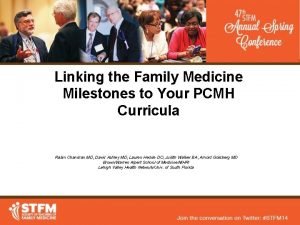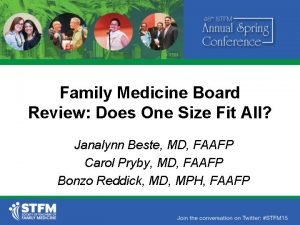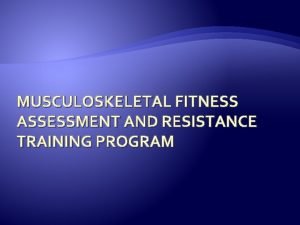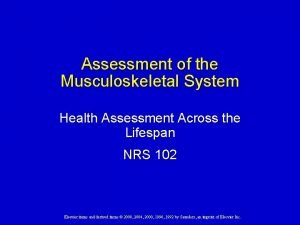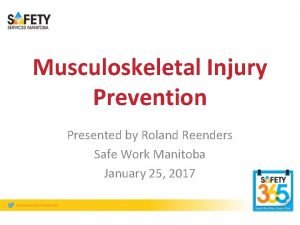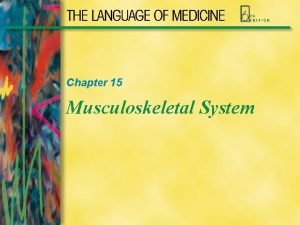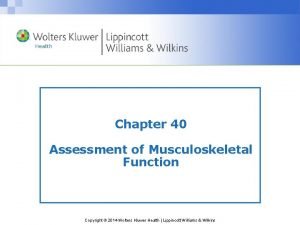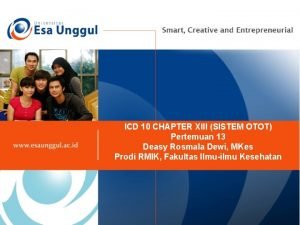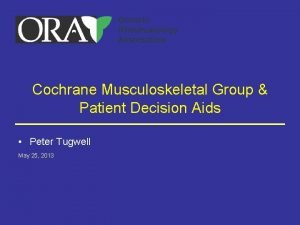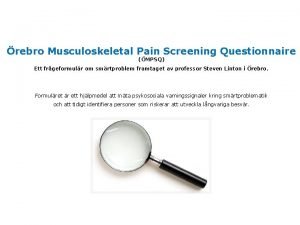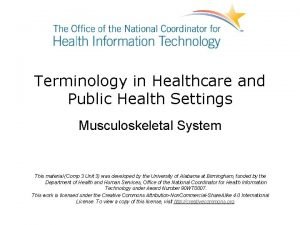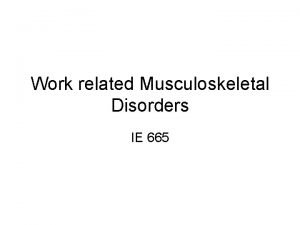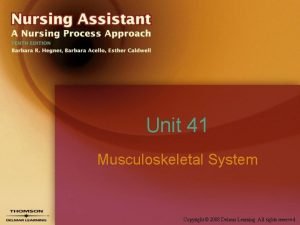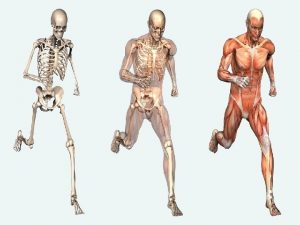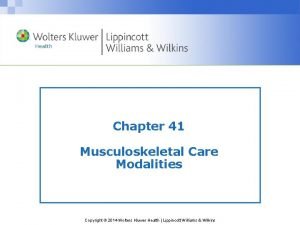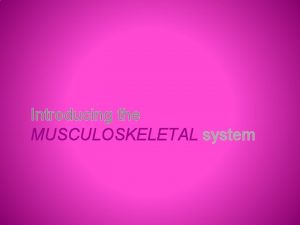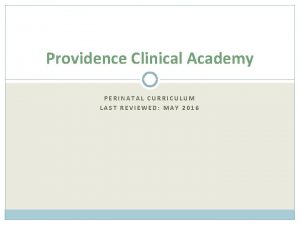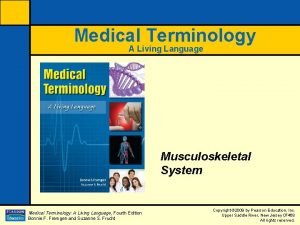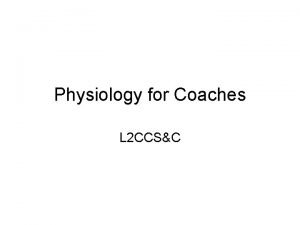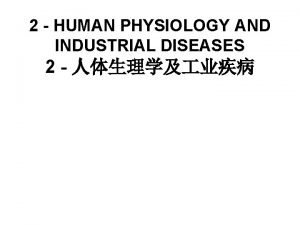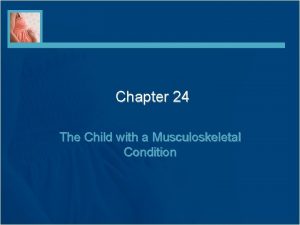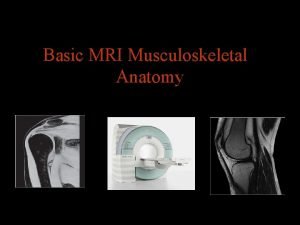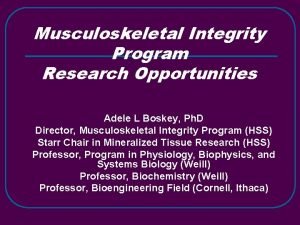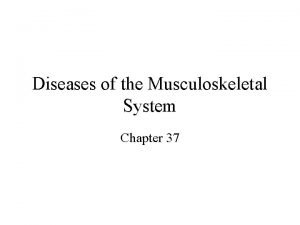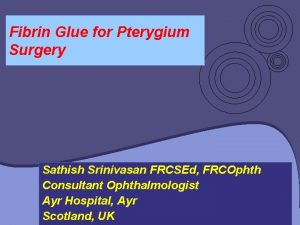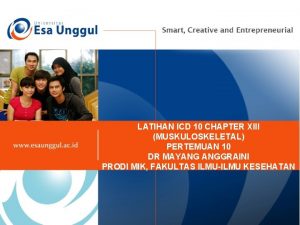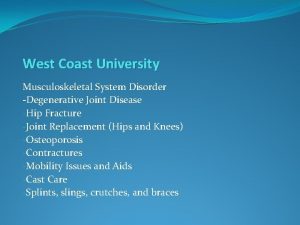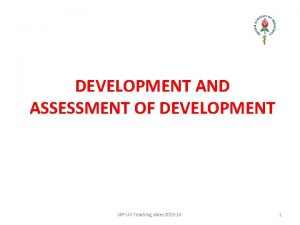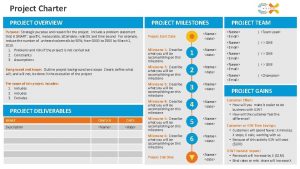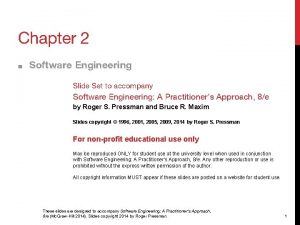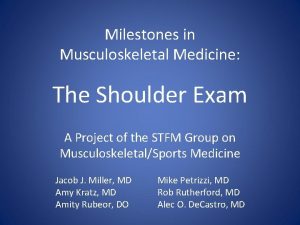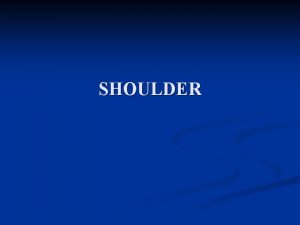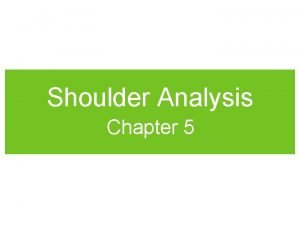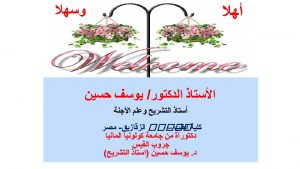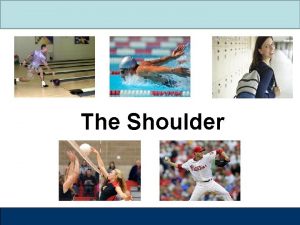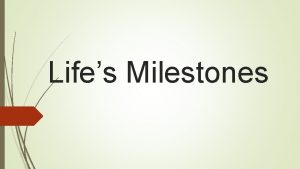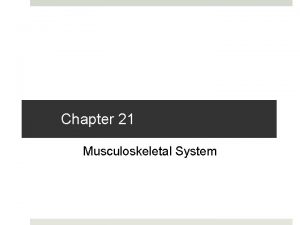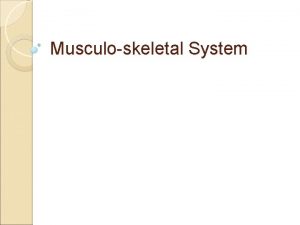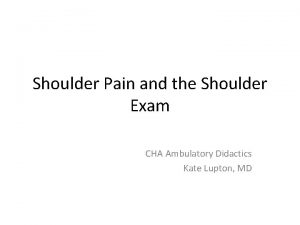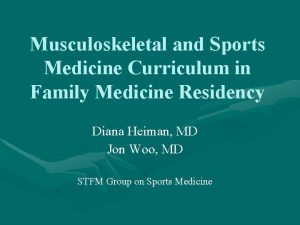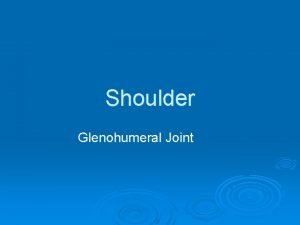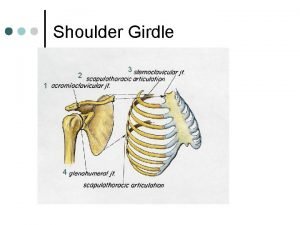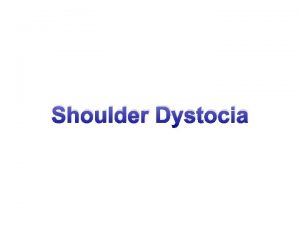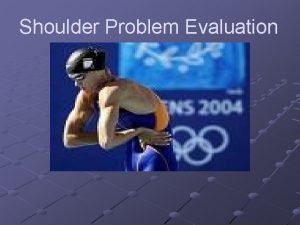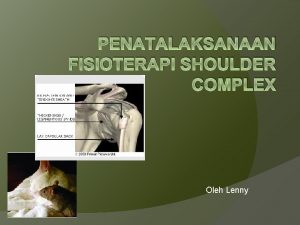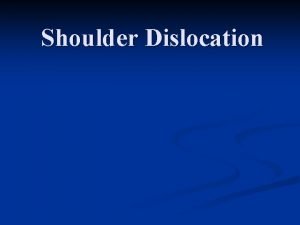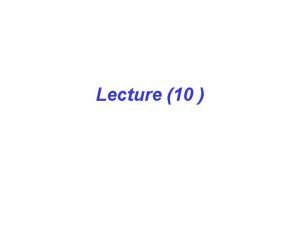Milestones in Musculoskeletal Medicine The Shoulder Exam A





































- Slides: 37

Milestones in Musculoskeletal Medicine: The Shoulder Exam A Project of the STFM Group on Musculoskeletal/Sports Medicine Jacob J. Miller, MD Amy Kratz, MD Amity Rubeor, DO Mike Petrizzi, MD Rob Rutherford, MD Alec O. De. Castro, MD

The Problem • Providers lack confidence in their MSK exams – Abou-Raya and Abou-Raya; Clinical Rheumatology, Oct 2010 • Up to 80% report “low level of confidence” • Knowledge deficits begin in med school/residency – Matheny, et al; American Journal of Orthopedics, Dec 2000 • 79% of FM residents had reduced ≤ 5 fractures • Average 5 weeks of orthopedic surgery training • Express more confidence in treating non-MSK conditions

The Problem • Specialties play larger role in MSK medicine – Hsu, Schwend, and Julia; Journal of Pediatric Orthopedics, Oct-Nov 2012 • Only 14% of referrals met AAP Surgery Advisory Panel guidelines for pediatric orthopedic evaluation – Liddell, Carmichael, and Mc. Hugh; Rheumatology, Aug 2005 • 51% of joint injections done by 15% of GP’s • 26% referred primary care joint injections to a colleague • Lack of specialist training associated with referral

Bulletin of the WHO, 2003 • “Improved Education in Musculoskeletal Conditions is Necessary for all Doctors” – Cited disproportional allotment of time in training vs. importance to practice • Only 3% of time in preclinical curriculum spent on MSK disorders • Electives focus on specialty care (surgery) rather than primary care • 3. 5% of residents choose rotations in ortho, <1% in sports med, rheum, or physical med

Bulletin of the WHO, 2003 • Outlined necessity for standards and defined outcomes – Preclinical • “Consecutive building of knowledge and skills” • Every new doctor should be able to: – – – Differentiate normal from abnormal Choose and interpret relevant tests Formulate differential diagnosis Recognize disease impact on the patient Make appropriate management plan – Clinical • Catered to local needs and disease prevalence • “Minimum competence…combined with basic knowledge” • Focused on appropriate attitude in managing chronic conditions/pain

Bulletin of the WHO, 2003 • Suggested effective teaching methods – Methods should be molded to shape objectives – Formal instruction (lecture, discussion) – Problem-based learning – Hands-on workshops – Real-life situations


Milestones in MSK Education • Curriculum resource for med students, residents, and evaluating faculty • Why? – Recognized need for increased competency in MSK care – Current Fam Med Milestones do not address specific abilities or skills needed for clinical care – Requirement for evidence-based PE skills – Standardize expectations

The Shoulder Exam • ~1% of all complaints presenting to primary care • Major component of overhead sporting injuries (swimming, baseball, football, etc. ) • Common in work-related injuries (overhead work, heavy lifting, etc. ) • Frequent injury of the elderly (transitioning, falls, etc. ) • Most common diagnosis: Rotator Cuff Tendinopathy

Which tests to use? Mazion Maneuver Codman Sign Palm Sign Finger Sign Dugas Calloways Bryants Sign Anterior Load and Shift Anterior Drawer Anterior Apprehension Jobe Relocation Rowe Throwing Leffert Surprise/Release Dynamic Anterior Jerk Dynamic Relocation Dynamic Anterior Stability Kinetic Medial Rotation Posterior Load and Shift Posterior Apprehension Jerk Fukuda Gagey’s Hyperabduction Sulcus Sign Inferior Apprehension Kibler’s Corkscrew O’Brien’s Anterior Slide Posterior Slide Luddington’s Curtain’s Kibler’s Grind La. Fosse AERS SLAPprehension Feagin Biceps Load Crank O’Driscoll’s Slap Pain Provocation Resisted Supination External Rotation Passive Compression Passive Distraction Supine Flexion Resistance Yergason’s Speed’s Abbot-Saunders Transverse Humeral Ligament Snap Hueter Sign Duga Sign Beru Sign Traction Compression Anterior/Posterior AC Shear Cross Chest Adduction Forced Adduction AC Distraction Paxino’s Neer Sign Hawkins-Kennedy Empty Can Copeland Impingement Horizontal Impingement Dawburn’s

Very few physical exam tests are diagnostic.

MSK Milestones Level 1: Medical Student • Shoulder Anatomy • Basic Physical Exam – Inspection – Palpation – Range of Motion – Strength

Shoulder Bones • Ball-and-socket joint • Scapula – – Spine Glenoid Fossa Acromion Coracoid • Humerus – Head – Greater Tubercle • Clavicle

Ligaments and Tendons

Posterior Muscles • • • Supraspinatus Infraspinatus Teres Minor Teres Major Deltoid

Anterior Muscles

Shoulder Capsule

Shoulder Bursae

Exam: Inspection • Inspect – Asymmetry – Atrophy – Bruising – Swelling

Exam: Palpation • Examine for crepitus and tenderness – Sternoclavicular Joint – Clavicle – Acromioclavicular Joint – Bicipital Groove – Glenohumeral Joint Line – Subacromial Space – Scapular Spine

Exam: Range of Motion • • Assess both active and passive ROM Forward Flexion 180° Extension 45° Abduction 150° External Rotation 90° Internal Rotation 90° Horizontal Adduction 130°

Exam: Strength Testing • Internal/External Rotation • Abduction • Empty Can Test: 90° shoulder abduction, 30° horizontal adduction, thumbs down, downward pressure – Isolates supraspinatus • Speed’s Test: Forearm supinated, 15° elbow flexion, resisted shoulder flexion – Isolates biceps

Level 2: Resident • Impingement: Compression of rotator cuff tendons • Hawkins-Kennedy Sign: 90° shoulder flexion, forearm pronated, 90° elbow flexion; perform internal/external rotation – Pain = + test – Most sensitive – Inpingement test: If subacromial space lidocaine injection relieves pain, diagnostic for impingement

Joint Instability • Apprehension Test: 90° shoulder abduction, 90° elbow flexion, 90° external rotation; apply posterior pressure on humeral head while externally rotating shoulder • Apprehension about shoulder dislocation = + test • Increase LR+ – Relocation Test (anterior humeral pressure relieves fear) – Surprise Test (quickly releasing anterior pressure causes fear recurrence)

• Shrug Sign: 90° shoulder abduction; elevating scapula or shoulder girdle during maneuver = + sign • Indicative of frozen shoulder, glenohumeral OA, or RC tendonopathy

Level 3: Fellow • Less evidence for clinical utility or few supporting studies • More specific pathology • Labral Tears – Crank Test: 160° shoulder abduction, 90° elbow flexion; place axial load on humerus and rotate iternally/externally. – Click + pain = + test

SLAP Lesion • “Superior Labral Anterior/Posterior” injury • Occurs during forced internal rotation • Yergason’s Test: 90° elbow flexion, thumb up; patient attempts to supinate forearm and flex elbow against resistance – Most specific – Pain = + test

SLAP Lesion Tests: Passive Distraction • Patient supine, 150° shoulder abduction, forearm supinated • Examiner stabilizes humerus and pronates forearm • Pain in glenohumeral joint = + test

Modified Dynamic Labral Shear • 120° shoulder abduction, 90° elbow flexion, 90° external rotation • Examiner places axial load and moves shoulder from 60 -120° abduction • Pain/clicking between 90 -120° = + test • LR+ 31. 57

Active Compression (O’Brien’s) Test • 90° shoulder flexion, 10° horizontal adduction, maximum internal rotation • Examiner applies downward force • Pain + click = SLAP injury • Pain alone = AC joint pathology

Subscapularis Tendon Tear • “Belly Off Test” – Examiner flexes and maximally internally rotates shoulder, patient’s hand on stomach – Wrist support removed – Hand elevating from stomach/wrist flexion = + test • High LR+

Full-Thickness Rotator Cuff Tear • External Rotation Lag Sign – 90° passive elbow flexion, 20° shoulder abduction, maximal external shoulder rotation – Remove external rotation support – Internal rotation = + test – The greater internal rotation, thicker the tear • Greatest LR+ for full-thickness supraspinatus tear

Bony Instability • Bony apprehension test • Detects: – Bankart lesion (injury to anterior/inferior labrum or glenoid fossa fracture due to anterior shoulder dislocation) – Hill-Sachs lesion (cortical depression in posterolateral humeral head) • 45° shoulder abduction and external rotation, 90° elbow flexion • Apprehensive about dislocation = + test • High LR+

A Note on Teaching • People learn in a variety of ways – – Visual: Viewing images, graphs, etc. Auditory: Listening to music or lectures Read/Write: Reading text and writing notes Kinesthetic: Moving, doing, touching • VARK questionnaire developed by Neil Fleming at Lincoln University, New Zealand – 16 questions used to determine how a person takes in information – “I’m different; not dumb” presented at 1995 HERDSA Conference

Preferred Modes: Breckler, Joun, and Ngo (2008) • Some people prefer one mode over all others, while some use a combination to obtain information • Studies of undergraduate and graduate students show a majority are multimodal • 60% show a significant kinesthetic component • Of unimodal students, kinesthetic and read/write were most preferred.

And now, a story about shoulders…

References • • • • Abou-Raya, A. and Abou-Raya, S. The inadequacies of musculoskeletal education. Clinical Rheumatology. 2010 Oct. 29(10): 1121 -1126. Akesson, K. , Dreinhofer, K. , and Woolf, A. D. Improved musculoskeletal education is necessary for all doctors. Bulletin of the World Health Organization. 2003 81: 677 -683. Breckler, J. , Joun, D. , and Ngo, H. Learning styles of physiology students interested in the health professions. Advances in Physiology Education. 2009 33: 30 -36. Fleming, N. D. I’m different; not dumb. Modes of presentation (VARK) in the tertiary classroom, in Zelmer, A. , (ed). Research and Development in Higher Education, Proceedings of the 1995 Annual Conference of the Higher Education and Research Development Society of Australasia (HERDSA). HERDSA, Volume 18, pp 308 -313. Hegedus, E. J. Which physical examination tests provide clinicians with the most value when examining the shoulder? Update of a systematic review with meta-analysis of individual tests. British Journal of Sports Medicine. 2012 46: 964 -978. Hsu, E. Y. , Schwend, R. M. , and Julia, L. How many referrals to a pediatric orthopaedic hospital specialty clinic are primary care problems? Journal of Pediatric Orthopedics. 2012 Oct. -Nov. 32(7): 732 -736. Kharb, P. , Samanta, P. R. , Jindal, M. , and Singh, V. The learning styles and the preferred teaching-learning strategies of first year medical students. Journal of Clinical and Diagnostic Research. 2013 June 7(6): 1089 -1092. Liddel, W. G. , Carmichael, C. R. , and Mc. Hugh, N. J. Joint and soft tissue injections. Rheumatology (Oxford). 2005 Aug. 44(8): 1043 -1046. Matheny, J. M. , et al. Confidence of graduating family practice residents in their management of musculoskeletal conditions. American Journal of Orthopedics. 2000 Dec. 29(12): 945 -952. O’Kane, J. Evidence based shoulder exam. Presentation given at the 2014 AMSSM Annual Conference, New Orleans, LA. Truntzer, J. , et al. Musculoskeletal education: an assessment of the clinical confidence of medical students. Perspectives in Medical Education. 2014 3: 238 -244. Woodward, T. and Best, T. The painful shoulder: part I. Clinical evaluation. American Family Physician. 2000 May 15 61(10): 3079 -3088. Wright, A. , et al. Diagnostic accuracy of scapular physical examination tests for shoulder disorders: a systematic review. British Journal of Sports Medicine. 2013 47: 886 -892.
 Milestones family medicine
Milestones family medicine Family medicine shelf percentiles
Family medicine shelf percentiles Abfm board review
Abfm board review Musculoskeletal fitness test
Musculoskeletal fitness test Objective data for musculoskeletal system
Objective data for musculoskeletal system Musculoskeletal injury
Musculoskeletal injury Chapter 15 musculoskeletal system step by step
Chapter 15 musculoskeletal system step by step Assessment of the musculoskeletal system
Assessment of the musculoskeletal system Muscle loss icd 10
Muscle loss icd 10 Cochrane musculoskeletal group
Cochrane musculoskeletal group The musculoskeletal system chapter 21
The musculoskeletal system chapter 21 ömpsq
ömpsq Musculoskeletal pronounce
Musculoskeletal pronounce Work related musculoskeletal disorders definition
Work related musculoskeletal disorders definition Musculoskeletal
Musculoskeletal Unit 41 musculoskeletal system
Unit 41 musculoskeletal system Muscle strength scale
Muscle strength scale Chapter 41 musculoskeletal care modalities
Chapter 41 musculoskeletal care modalities Musculoskeletal system
Musculoskeletal system Musculoskeletal
Musculoskeletal Inversion medical terminology
Inversion medical terminology Musculoskeletal
Musculoskeletal Musculoskeletal system
Musculoskeletal system Musculoskeletal system
Musculoskeletal system Buck's extension traction
Buck's extension traction Musculoskeletal mri anatomy
Musculoskeletal mri anatomy Musculoskeletal integrity
Musculoskeletal integrity Chapter 6 musculoskeletal system diseases and disorders
Chapter 6 musculoskeletal system diseases and disorders Diseases of the musculoskeletal system
Diseases of the musculoskeletal system Sathish srinivasan
Sathish srinivasan Icd 10 code for musculoskeletal spasm
Icd 10 code for musculoskeletal spasm West coast musculoskeletal
West coast musculoskeletal Iap ug teaching slides 2020
Iap ug teaching slides 2020 Internet milestones
Internet milestones Milestone in project charter
Milestone in project charter Early adulthood milestones
Early adulthood milestones Social engineering phase in public health
Social engineering phase in public health Slidetodoc.com
Slidetodoc.com
